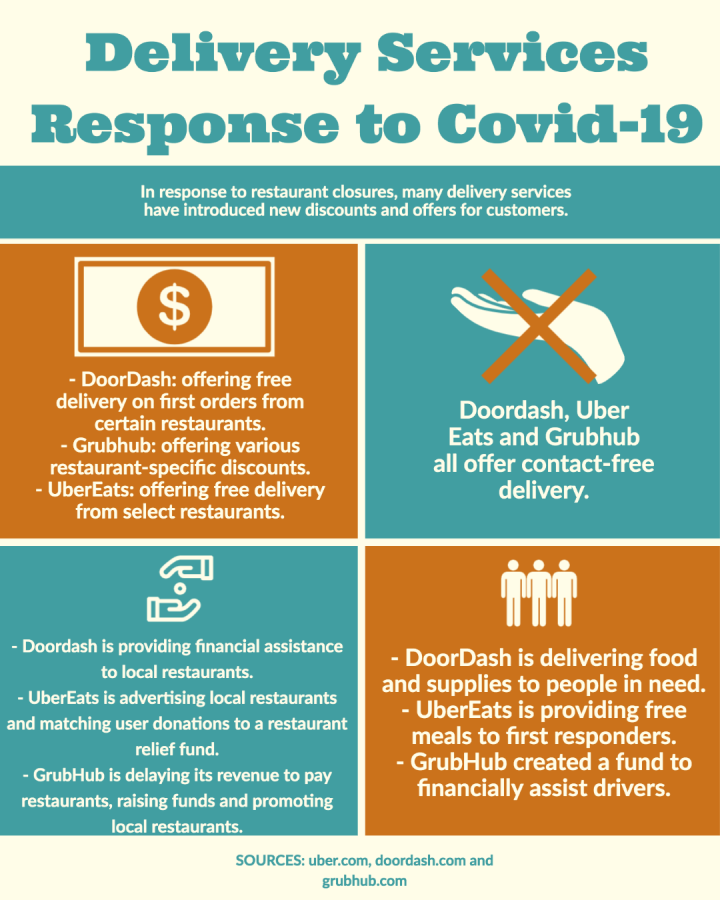Delivery services review: A solution to your social-distancing food woes
April 20, 2020
With restaurants closed for dine-in, I can think of no better way to support local restaurants and contractors than by ordering delivery meals. The rise of apps like Uber Eats and DoorDash makes that task easy, but Grubhub is the best service to use because of its low cost, wide restaurant variety, ease-of-use and support for local businesses.
Grubhub has the cheapest pricing of food delivery apps. When I set up orders from The Halal Guys at the same time to my home, Grubhub only had $4.17 of taxes, fees and delivery pricing, DoorDash had $6.37 and Uber Eats had $4.93. The costs totaled to $18.15, $20.34 and $18.90, respectively.
Uber Eats has around 150 delivery options available to my address and DoorDash has around 200, while Grubhub lags behind at around 100 restaurants. However, Grubhub does have significantly more takeout options, but it doesn’t feature staple American fast-casual chains like Chipotle. These numbers can fluctuate, however, depending on deals that each company makes with the restaurants.
All three apps have a subscription service for $9.99 a month. DoorDash offers free delivery and reduced service fees for orders over $12 at its partner restaurants with DashPass. Uber Eats offers free delivery and 5 percent off orders of $15 with Eats Pass. However, Grubhub offers free delivery for all orders, 10 percent cash back and premium customer service with Grubhub+, making Grubhub the clear winner for subscription services.
Grubhub also has the most lucrative deals, such as percentage-based discounts on large orders, all contained within a section called “Perks.” Uber Eats and DoorDash both have discounts and free delivery deals on an individual-restaurant basis, but they are insignificant compared to Grubhub’s variety.
Grubhub’s main flaw is an overly simplistic, unappealing display. Its search button and other buttons are not as defined, making it harder to navigate and immediately find a specific restaurant. However, it shows around six restaurants at a time while scrolling, compared to Uber Eats’ two and DoorDash’s three, allowing a clearer view of all available restaurants. Uber Eats’ display is also unappealing, as the layout is extremely clunky.
DoorDash, on the other hand, maintains the perfect balance: an inviting layout with everything clearly displayed and an accessible map for pick-up options and delivery tracking.
Each company has had a different approach to handling the current pandemic, although they all have added an option for no-contact deliveries in which the deliverer leaves the product outside of the buyer’s door and notifies them through the app.
Grubhub is suspending commission payments—what restaurants pay for being on the service—for independent restaurants. DoorDash is suspending commissions for only its partner restaurants. Uber Eats is eliminating delivery fees for buyers to encourage ordering.
All three of them have been partnering with more restaurants to incentivize purchases. They are also offering discounted or free delivery and fee cancelation promotions during this period of economic slowdown.
Uber Eats does have the perk of being connected to one’s Uber account, meaning that it shares credit card payments and overall Uber Rewards points, but all-in-all it’s extremely bland because of its unintuitive appearance, few discounts and limited variety. Similarly, DoorDash is overpriced, though it does have the greatest amount of restaurant options and the most appealing layout.
Grubhub reigns supreme. Its unbeatable deals, pricing, and simplicity make it the best option, with DoorDash coming in for a close second.
Even so, restaurants make more of a profit when they are ordered from directly, which is something to consider when ordering because many are struggling to stay afloat.








